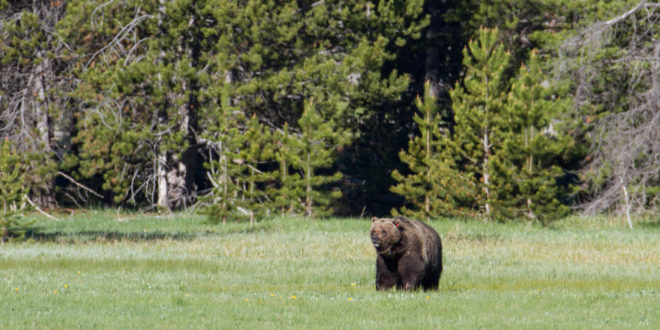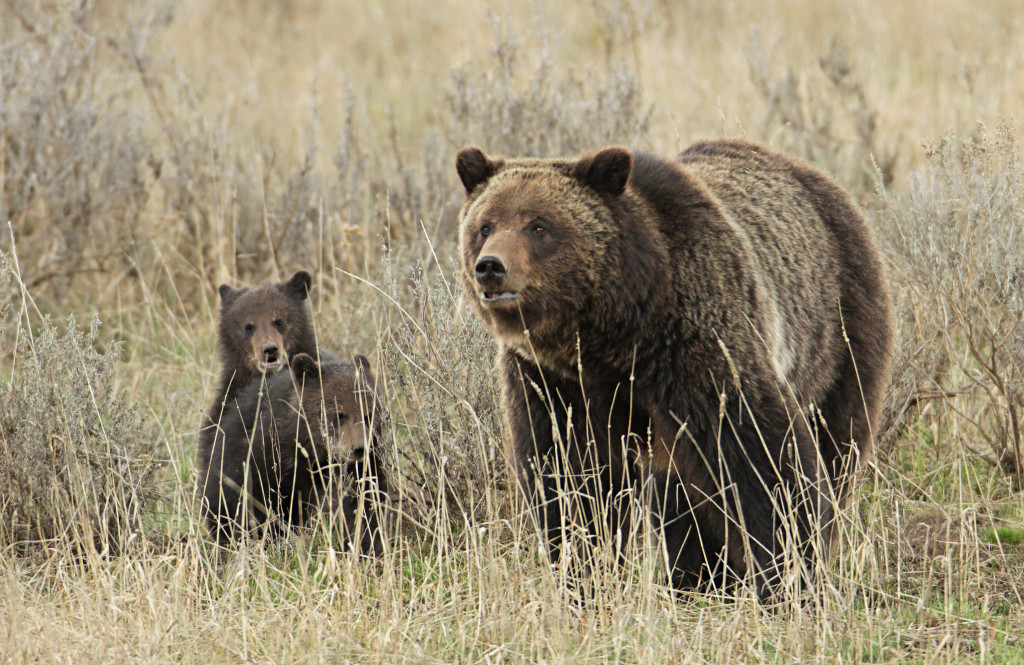Yellowstone Superintendent Dan Wenk has expressed concern over the future of Yellowstone’s grizzly population.
Per Wenk, speaking to Wyofile, a proposal from the U.S. Fish and Wildlife Service to delist Yellowstone area grizzly bears from the Endangered Species List could lead to a worrying decline in the population—a concern shared by many visitors to Yellowstone National Park who hope to see grizzlies and other bears.
Just a few weeks ago, Wenk was the sole dissenter at a meeting of the Yellowstone Ecosystem Subcommittee, voting no on a proposed conservation strategy. Wenk expressed disappointment that the plan didn’t put more focus on the population’s long-term health, especially in the immediate aftermath of a delisting proposal. From Wyofile:
The reason there is potential for a declining population lies in the scientific methods used to determine grizzly numbers, whether those methods will change, and whether such changes might result in the loss of hundreds of bears throughout the Yellowstone area.
As envisioned by Fish and Wildlife, bears will continue to be counted using what’s known as the Chao 2 method. Researchers generally agree it is a conservative model that underestimates the population. The latest calculation using Chao 2 estimates there are about 690 grizzlies in the “Demographic Monitoring Area” in and around Yellowstone. Federal post-delisting plans have a goal for three states around Yellowstone — Idaho, Montana and Wyoming — to manage for an average of 674 grizzlies in the area.
But federal post-delisting plans also call for using the “best-available science” in monitoring grizzlies. That’s what worries Wenk.
What would happen, the superintendent asked, if a new, “best-available-science” population calculation method was adopted. What if a new method estimated there were 1,000 or 1,100 grizzlies in the area? Those are figures that many wildlife experts believe are more accurate than numbers derived from Chao 2. Already a counting method known as “mark-resight” has been touted by researchers as a more accurate estimator.
In such an instance — where the population estimate increases due to a change in methods — federal plans do not also call for raising the management goal of only 674 grizzlies. So instead of having only 19 bears above objective — as is the situation today — bear counters would see 319 or 419 bears above objective.
That could put something like 400 bears at risk, Wenk said, potentially altering the entire ecosystem.
“I believe it changes [the current situation] dramatically,” Wenk said. “My fear is if they use another method of counting … they’ll implement higher rates of mortality to drive the population down.”
Wenk says he also fears that, even if a new counting method uncovers more grizzlies in the Yellowstone area, the new count would not be factored into state or federal plans. Wenk uses the word “recalibrate” to describe what he hopes agencies would do when presented with a new count.
“Nowhere does it give me the assurance that we’re managing for a stable population at the time of delisting,” Wenk told Wyofile.
Wenk’s concerns face widespread opposition from other members of the Subcommittee, with some saying Wenk’s concern for Yellowstone’s grizzlies is mitigated by the scope of the Park. From Wyofile:
Wyoming Game and Fish Chief Game Warden Brian Nesvik said he’s talked extensively with Wenk about the topic and believes Yellowstone will be OK. Mortality limits agreed to by states and Fish and Wildlife are a “stopgap” that would keep numbers from falling.
“I strongly believe the mission of the parks and the mission of the state can be achieved simultaneously,” Nesvik said. “[Wenk’s] mission and their preservation model in the park is not impacted by the state’s mission and the state’s objectives outside the park.”
Even if managers find there are more than 750 grizzlies in the area, “there still is a cap or limit on the number of bears that can be taken,” he said. “We’re bound by those recovery criteria, that have mortality limits.”
Wyoming has allowed black bear hunting right up to park boundaries, with no corresponding loss of black bear viewing opportunities in national parks, Nesvik said. That population is “as high or higher than it’s ever been.”
“This really comes down to the fundamental belief of the state that the ESA science establishes what recovery is. When that’s achieved, management goals lie with the state. That’s what the law requires.”
Regional National Park Service Director Sue Masica has echoed Wenk’s concerns, saying that hunting outside Yellowstone National Park could particularly impact so-called “roadside bears” who venture out of the Park.
The state of Wyoming has not released any information regarding potential hunting plans, although it has (like Montana and Idaho) submitted a draft plan to the USFWS. Per Wyofile, a potential hunting plan could include hunting along Park boundaries or even in the John D. Rockefeller Jr. Memorial Parkway. State officials have said their first focus would be on bears “that get into conflicts” or live along the edge of the Greater Yellowstone Ecosystem.
 Yellowstone Insider Your Complete Guide to America's First National Park
Yellowstone Insider Your Complete Guide to America's First National Park







You must be logged in to post a comment.